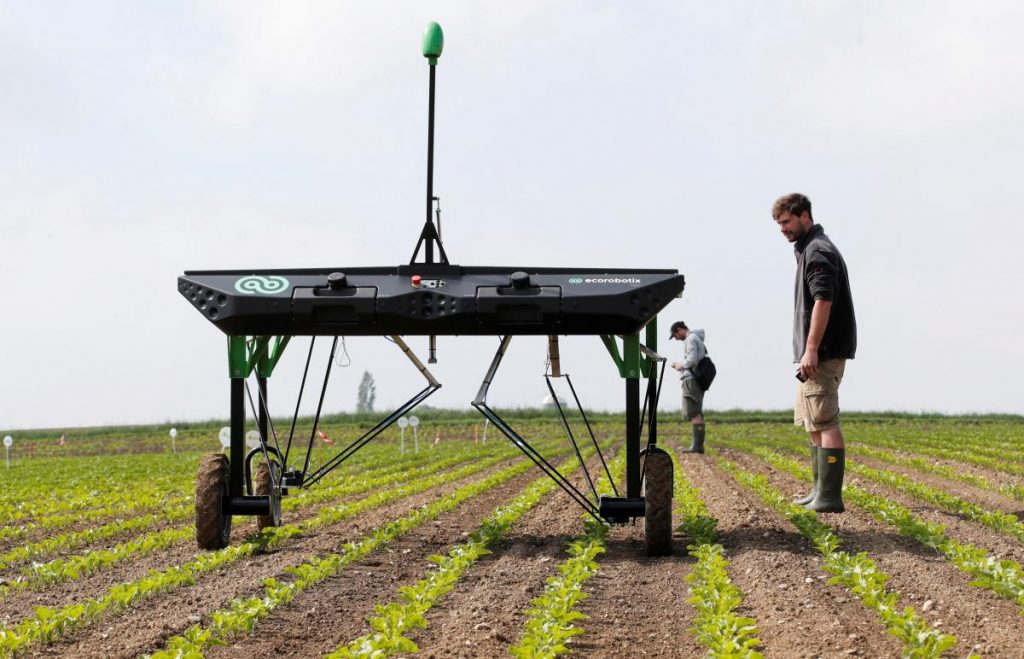 Yes, you heard us right. Robotics is coming to agriculture.
Yes, you heard us right. Robotics is coming to agriculture.
Companies around the world are racing to develop new tools in this rapidly growing field. China just launched a seven-year program to develop “autonomous agriculture” (Minter, 2018), and organic farmers in Australia are getting a $250,000 government grant to use robotic weeders on their organic tomato farms.
In 2017, a university-private sector collaborative group in the U.K. claimed to have planted, tended, and harvested a crop of barley 100% autonomously, using programmed farm vehicles and drones.
Experts in this field advocate for “‘sustainable intensification’ — information-intensive farming methods for growing more food on a given amount of land, with less energy or herbicide inputs” (Zimmermann, 2018).
However, given the soaring herbicide use over the last 30 years of industrial ag, one of the most tantalizing applications of robotics might be in the battle all farmers have to wage every year — keeping weeds from stealing sunshine, moisture, and plant nutrients needed by crops.
Weed killing robots sound pretty futuristic, but several companies are already working on prototypes, and some even have market-ready models. So, get ready to spy some high-tech devices in a field near you. These robots use mechanical hoes, lasers, tillage, and herbicides to practice what some are calling “precision farming.”
A few examples:
Mechanical Weeding Robots
One method robots are using to tackle weeds is old fashioned elbow grease, only with robotic muscle. This example from French company Naio Technologies costs around $33,000 and uses mechanical hoes to weed a 300 foot row in less than five minutes. Several sizes are available to fit different row widths. The robot, quaintly named Oz, can be controlled via remote control or precision-guided via a RTK satellite navigation system (the same technique used by John Deere’s latest GPS-guided tractors). It even talks to the farmer’s cell phone and send text alerts when it finishes a job or runs into an obstacle.
A much smaller model by the maker of the robot vacuum Roomba sells for around $300 and is designed for autonomous weeding in home gardens.
Laser-Shooting Robots
With an extra dose of sci-fi, another type of robotic weeder uses lasers to destroy weeds.
Professor Simon Blackmore at the National Centre for Precision Farming at Harper Adams University in the U.K. has developed a prototype weed zapper he calls the “Hyperweeder.” It uses pattern-recognition software and cameras to identify weeds. It is programmed for 26 weeds species so far, and can identify the location of the meristem where new plant growth occurs, which it then zaps with a miniature laser cannon.
The beam blasts the weeds’ growing tips with temperatures up to 203 degrees Fahrenheit. The prototype model shown in the image below is towed behind a tractor, but autonomous models are in the works.
Blackmore hopes that this kind of precision weeding can replace herbicides, or at least greatly increase the efficiency of farming. Where some chemical control is needed, the Hyperweeder also comes in a model with herbicide spray guns (Zimmermann, 2018).

Precision Herbicide Applicator Robots
Several robots are in the works that developers hope will reduce herbicide use by up to 99% through precision application directly on individual weeds. This would mean “much less environmental impact and much less herbicide residue left on harvested food” (Zimmermann, 2018).
One model gaining steam is made by ecoRobotix, a Swiss company whose weed-killing robot is “solar-powered and can kill weeds for 12 hours straight without an operator at the helm” (Scolaro, 2018). It uses camera-guided AI and robotic arms to spray precise doses of herbicide only on weeds, and the company estimates it uses 20-times less herbicide than standard methods.
The spider-like robot (pictured top right, Photo: Reuters) must have inspired many who saw it in action; ecoRobotix just secured an additional $10 million in financing to continue development. It really is a sight to see- check it out in the video by CNBC below.
Visions of Star Wars droids zapping herbicide-resistant pigweed will surely grab the attention of farmers growing tired of the herbicide-treadmill. But robotic farming raises many questions about one of our favorite topics here on Hygeia — unintended consequences. While less herbicide use is always a good thing, how will automated agriculture impact the farm economy and farm jobs? What happens when the satellite goes down? And how will farmers, especially in the developing world, adapt to the new high-tech skill set needed to operate this kind of equipment?
Stay tuned as we keep our sights on this futuristic development.
Sources:
Chrisina Medici Scolaro, “This weed-killing AI robot can tell crops apart,” CNBC, June 4, 2018.
Siobhan Walsh, “Taking the hardship out of weeding with a robot,” AgriLand, December 14, 2017.
Nils Zimmermann, “Could agricultural robots replace glyphosate?,” DW, April 6, 2018.

